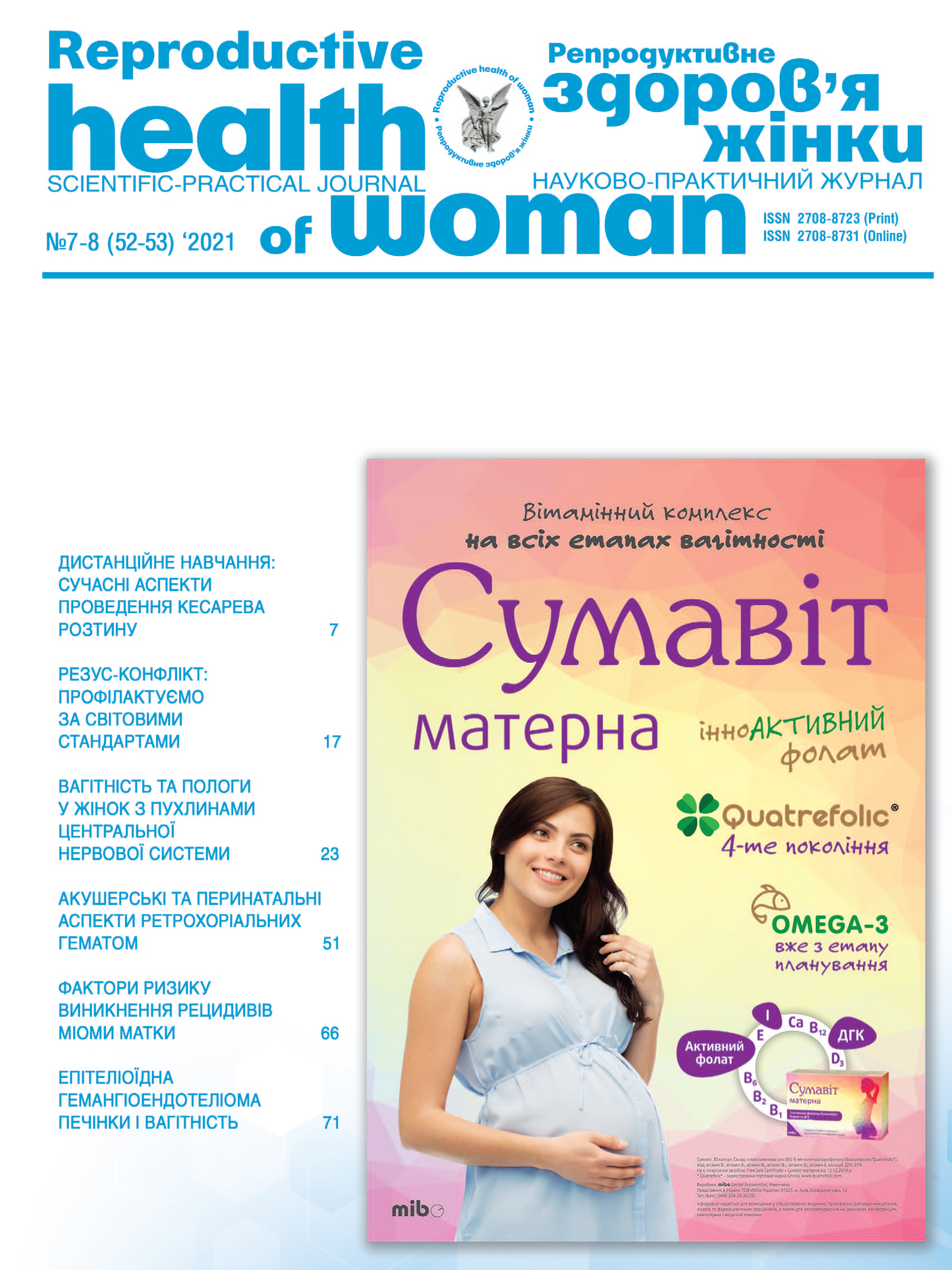Акушерські та перинатальні аспекти ретрохоріальних гематом
Основний зміст сторінки статті
Анотація
Проблема невиношування вагітності до сьогодні не втрачає своєї медико-соціальної, наукової та практичної значущості. Майже 85% втрат вагітностей припадає на І триместр гестації (до 13 тиж), інші 15% – на ІІ і ІІІ триместри. Однією з багаточисленних причин кровотеч у І триместрі гестації є ретрохоріальна гематома (РХГ) – скупчення крові у ретрохоріальному просторі внаслідок часткового відшарування хоріальної пластинки від прилеглої децидуальної оболонки при генетично нормальному ембріоні.
У статті наведений аналіз наукових публікацій, у яких висвітлено акушерські й перинатальні характеристики РХГ, що виникають у І триместрі вагітності, етіологічні особливості їхнього виникнення і важливі аспекти лікування для уникнення розвитку подальших ускладнень, збереження та пролонгації вагітності. Розглядаються особливості діагностики і подальшої терапії для забезпечення ранньої підтримки вагітності та зниження частоти розвитку гестаційних ускладнень. Велике прогностичне значення у діагностиці РХГ має ультразвукове дослідження матки, за допомогою якого можна виявити загрозливі ознаки переривання вагітності, що асоціюється з передчасними пологами, розвитком синдрому затримки росту плода, відшаруванням плаценти у ІІ і ІІІ триместрах, низькою масою тіла при народженні.
Дані сучасних світових досліджень свідчать, що при встановленні діагнозу РХГ за наявності живого генетично нормального ембріона призначення патогенетичної терапії, яка сьогодні ґрунтується на гестагено- й антифібринолітичній терапії, є запорукою успішності лікування даної перинатальної патології, значного зменшення кількості випадків втрат вагітності та підвищення якості перебігу гестаційного процесу.
Сьогодні перед практикуючими акушерами-гінекологами стоять завдання з пошуку нових доклінічних ознак для прогнозування можливих ускладнень перебігу вагітності і розроблення дієвих алгоритмів профілактики і лікування, що дозволятиме пролонгувати вагітність на тлі РХГ і досягти сприятливих перинатальних результатів.
Блок інформації про статтю

Ця робота ліцензується відповідно до Creative Commons Attribution 4.0 International License.
Автори зберігають авторське право, а також надають журналу право першого опублікування оригінальних наукових статей на умовах ліцензії Creative Commons Attribution 4.0 International License, що дозволяє іншим розповсюджувати роботу з визнанням авторства твору та першої публікації в цьому журналі.
Посилання
Konkov DG. Features of pregnancy in women with subchorionic hematomas on the background of gestational endotheliopathy. Medicines of Ukraine. 2013;2(168):54-7.
Pelinescu-Onciul D. Subchorionic haemorrhage treatment with dydrogesterone. Gynecol. Endocrinol. 2007;23:77-81.
Zhyvetska-Denisova AA, Vorobyova II, Tkachenko VB, Rudakova NV. Miscarriage: modern approaches to diagnosis, prevention and treatment. Perinatology and pediatrics. 2017; 2(70):91-8.
Hu L, Du J, Lv H [et al.]. Influenc in gfactors of pregnancy loss and survival probability of clinical pregnancies conceived through assisted reproductive technology. Reprod Biol Endocrinol. 2018; 16(1):74.
Jeve YB, Davies W. Evidence-based management of recurrent miscarriages. J Hum Reprod Sci. 2014; 7(3):159-69.
Konkov DG, Bulavenko OV, Dudnik VM, Buran VV. Modern aspects of pathogenetically determined prevention of preeclampsia. Perinatology and pediatrics. 2016; 1:46-50.
Radzinsky BE. Undeveloped pregnancy: a guide. M.: GEOTAR-Media; 2017. 176 р.
Vovk IB, Trokhimovich OV, Revenko OO. Pathogenetic links of early pregnancy losses. Reproductive health Eastern Europe. 2013; 3(27):8-14.
Romanenko TG, Zhaloba GM, Staselovich LYu, Voronina KI. Pregnancy management on the background of retrochorial hematoma in the first trimester of gestation (Literature review). Women’s health. 2018; 9(135):118-24.
Nagy S, Bush M, Stone J, Lapinski R, Gardó S. Orv Hetil. Clinical significance of subchorionic and retroplacental hematomas detected in the first trimester of pregnancy. Obstet Gynecol. 2005;146(42):2157-61.
Kiryushchenkov PA [et al.]. Clinical and laboratory and ultrasound evaluation, tactics of pregnancy in various forms of chorionic pathology in the first trimester. Obstetrics and gynecology. 2010;1:19-23.
Kravchenko OV, Boyko IV. Predictors of placental dysfunction and methods of its correction in patients with retrochorial hematoma in the first trimester of gestation. Reproductive endocrinology. 2018;1(39):2-6.
Dogra V, Paspulati R M, Bhatt S. First trimester bleeding evaluation. Ultrasound Q. 2005;21(2):69-85.
Crane S, Collins L, Hall J. [et al.]. Reducing utilization by uninsured frequent users of the emergency department: combining case management and drop-in group medical appointments. J Am Board Fam Med. 2012;25(2):184-91.
Henik NI, Lytvyn NV, Kinash NM. The course of pregnancy with detachment of the chorion and placenta at different stages of gestation. Taurian Medical and Biological Bulletin. 2012;15(2, 58):48-50.
Asato K, Mekaru K, Heshiki C [et al.]. Subchorionic hematoma occurs more frequently in in vitro fertilization pregnancy. Eur J Obstet Gynecol Reprod Biol. 2014;181:41-4.
Pirogova VI, Missouri AG, Prokopiv IV. Retrochorial hematomas of the first trimester - risks and problems of prolonging pregnancy. Health of Ukraine. 2012; 4(8):18-9.
Dyak KV, Yuzko OM. Causal factors of premature birth (A new look at the problem). Neonatology, surgery and perinatal medicine. 2017;1(23):62-9.
Norman C. Smith, E. Five M. Smith. Ultrasound diagnostics in obstetrics and gynecology: lane. with English under ed. Goose AI. M.: Practical Medicine; 2015. 296 р.
Kovaleva YuV. Retrochorial hematoma. Questions of etiopathogenesis, diagnostics, therapy. Journal of Obstetrics and Gynecology. 2013; 62(4):37-47.
Gerasimenko VA, Hovhannisyan NA. Estimation of D-dimer concentration in clinical and laboratory practice. Handbook of the head of the clinical diagnostic laboratory. 2011;8: 75-7.
Bushtyreva IO, Kuznetsova NB, Kaplina AA, Kovaleva AV, Dmitrieva MP [et al.]. Hemostasis in patients with retrochorial hematoma. Obstetrics, gynecology and reproduction. 2016;10(2):16-22.
Miyakis S, Lockshin MD, Atsumi T, Branch DW, Brey RL, Cervera R, [et al.]. International consensus statement on an update of the classification criteria for definite antiphospholipid syndrome (APS). J Thromb Haemost. 2006;4:295-306.
Tomnyuk OM. Prevention of miscarriage and perinatal pathology in women with antiphospholipid syndrome and retrochorial hematoma. Women’s reproductive health. 2020; 3(43):36-9.
Kravchenko OV. Correction of bleeding in early gestation depending on the condition of the embryo and extraembryonic structures. Women’s health. 2017; 2(118):22-5.
Maltseva LI, Zefirova TP, Abdulina IV. The importance of antifibrinolytic drugs in the prevention of obstetric bleeding. Practical medicine. 2010; 4(43):83-5.
Dankina IA, Dankina VV, Chistyakov AA, Dankin KV. Features of combination therapy in patients with retrochorial hematoma in the first trimester of pregnancy. Journal of Hygiene and Epidemiology. 2018;22(3):36-9.

